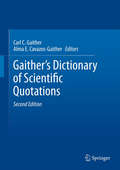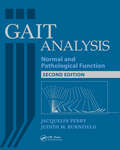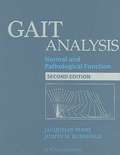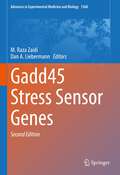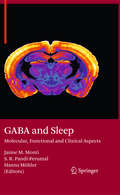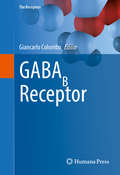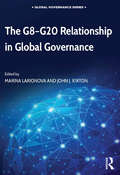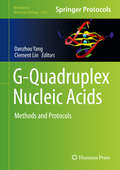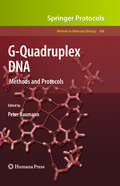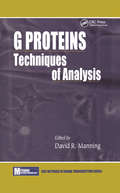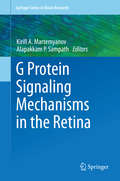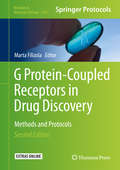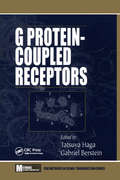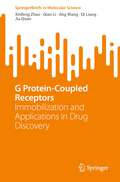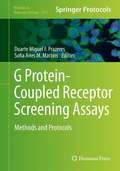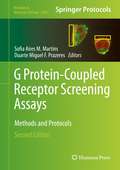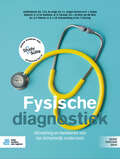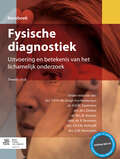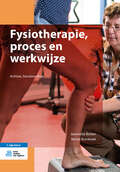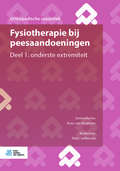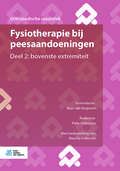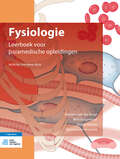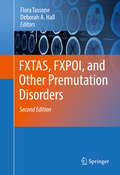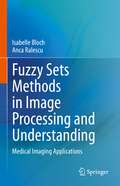- Table View
- List View
Gaither's Dictionary of Scientific Quotations
by Carl C. Gaither Alma E. Cavazos-GaitherThis unprecedented collection of 27,000 quotations is the most comprehensive and carefully researched of its kind, covering all fields of science and mathematics. With this vast compendium you can readily conceptualize and embrace the written images of scientists, laymen, politicians, novelists, playwrights, and poets about humankind's scientific achievements. Approximately 9000 high-quality entries have been added to this new edition to provide a rich selection of quotations for the student, the educator, and the scientist who would like to introduce a presentation with a relevant quotation that provides perspective and historical background on his subject. Gaither's Dictionary of Scientific Quotations, Second Edition, provides the finest reference source of science quotations for all audiences. The new edition adds greater depth to the number of quotations in the various thematic arrangements and also provides new thematic categories.
Gait Analysis: Normal and Pathological Function
by Jacquelin Perry Judith BurnfieldThe extensive and ground-breaking work of Dr. Jacquelin Perry is encompassed and detailed in the world renowned text, Gait Analysis: Normal and Pathological Function. The medical, healthcare, and rehabilitation professions key text for over 18 years on gait….Now available in a much anticipated New Second EditionDr. Jacquelin Perry is joined by Dr. Judith Burnfield to present today's latest research findings on human gait. Gait Analysis, Second Edition has been updated and expanded to focus on current research, more sophisticated methods, and the latest equipment available to analyze gait.What is New:• A new chapter covering running• Synergy of motion between the two limbs• A new chapter covering pediatrics • A new chapter covering stair negotiation• New and updated clinical examples• A section on power inside each chapter covering normal gait• New methods and equipment to analyze gaitThis Second Edition to Gait Analysis offers a re-organization of the chapters and presentation of material in a more user-friendly, yet comprehensive format. Essential information is provided describing gait functions, and clinical examples to identify and interpret gait deviations. Learning is further reinforced with images and photographs.Features:• Six sections cover the fundamentals, normal gait, pathological gait, clinical considerations, advanced locomotor functions, and gait analysis systems• Clinical significance of the most common pathological gait patterns• Over 470 illustrations and photographs, as well as 40 tables• Patient examples to illustrate elements of normal and pathological gaitTens of thousands of orthopedic, orthotic and prosthetic, physical therapy, and other rehabilitation professionals have kept a copy of Gait Analysis by their side for over 18 years…join the thousands more who will bring the Second Edition into their clinics, classrooms, and personal collections.
Gait Analysis: Normal and Pathological Function
by Jacquelin Perry Judith M. BurnfieldDr. Jacquelin Perry is joined by Dr. Judith Burnfield to present today's latest research findings on human gait. Gait Analysis, Second Edition has been updated and expanded to focus on current research, more sophisticated methods, and the latest equipment available to analyze gait.
Gagueira: uma abordagem natural e prática para o tratamento
by A. N. OkonobohO que é a gagueira? As principais causas da gagueira e como solucionar esses problemas a trevez do controle respiratório e des exercícios de fala. Esses são alguns dos temas a bordados nessa publicação que apresenta a gagueira como a falta de habilidade de coordenar os órgãos responsáveis pela fala. Aléd disso, como os pais, familiares e pessoas próximas desenvolvem um papel importante nesse processo.
Gadd45 Stress Sensor Genes (Advances in Experimental Medicine and Biology #1360)
by M. Raza Zaidi Dan A. LiebermannThis second edition is fully updated throughout and covers the emerging evidence that indicates that the Gadd45 family of proteins plays a unique and critical role as sensors of stress, including genotoxic, physiological, and oncogenic stress. It sheds light on the complex cellular stress response, encompassing myriad molecular pathways with a plethora of regulators and effectors.The GADD45 stress response genes encode small (18 kd) nuclear/cytoplasmic proteins. These genes are rapidly induced by a wide variety of endogenous and exogenous stress stimuli. Despite marked similarities, Gadd45 genes are regulated differentially and exhibit functional diversity. Gadd45 proteins respond to physiological and oncogenic stress, and are implicated in cell cycle arrest, DNA demethylation and repair, apoptosis, cell survival, genomic stability, and inflammation. The purpose of this book is to provide a comprehensive overview of the unique global role that Gadd45 proteins play as stress sensors and the molecular pathways involved.
GABA and Sleep
by Jaime M. Monti Hanns Möhler Seithikurippu Ratnas Pandi-PerumalGABA (gamma-aminobutyric acid) is the main neurotransmitter regulating sleep. The majority of drugs presently in use for the treatment of sleep disorders act by enhancing GABAergic neuronal inhibition. The GABA system is, therefore, of prime clinical relevance for the therapy of insomnia. The focus of this volume is on the neuropsychopharmacology and the clinical impact of the GABA system in regulating sleep and wakefulness. It presents molecular, neuropharmacological, systems-biological and clinical approaches to the understanding of the mechanism of action of GABA and GABAergic drugs. It also explores the role of GABA in the basic drives that affect sleep, and the influences that adapt sleep and wakefulness to external events.
GABAB Receptor
by Giancarlo ColomboAn up-to-date comprehensive overview of the GABA B receptor system with a particular focus on the most recent therapeutic applications and potential. This receptor system has recently been implicated in several diseases and disorders including gastroesophageal reflux disease, epilepsy, mood disorders, depression, and alcohol and substance use disorder. The authors, leading researchers in the field, explore a number of approaches, including medicinal chemistry, molecular biology, physiology, and preclinical and clinical pharmacology. This overview provides a translational perspective on the potential of the GABA B receptor pharmacology.
The G8-G20 Relationship in Global Governance (Global Governance)
by Marina Larionova John J. KirtonIf the growing demand for global governance breathed new life into the established G7/8 and the more recent G20, it raised questions about the evolving and optimal relationship between them. One answer arose from the G20’s third summit, when it proclaimed the G20 would govern global finance and economics, while the old G8 would focus on development and security. Yet this rough division of labour did not address which issues lay within each category and how interconnections would be addressed to create comprehensive, coherent global governance for a complex world. This volume considers these questions. It explores the summits’ performance, the division of labour during their coexistence, their comparative strengths and limitations, and how the future partnership could be improved to benefit the global community. The authors explain the recent evolution and performance of the G8 and G20 summits and their evolving empirical relationship. They consider the G8/G20 relationship with other actors engaged in global governance, notably the major multilateral organizations and civil society. They assess G7/8 and G20 effectiveness and accountability. And they identify, based on this empirical and analytical foundation, how the relationship can be improved for today’s tightly wired world.
G-Quadruplex Nucleic Acids: Methods and Protocols (Methods in Molecular Biology #2035)
by Danzhou Yang Clement LinThis volume covers the structures, properties, and functions of G-quadruplexes in a wide range of biological disciplines, including therapeutic intervention and biomaterial application. The chapters in this book explore a wide range of vital and new experimental techniques used in the study of G-quadruplexes. Written in the highly successful Methods in Molecular Biology series format, chapters include introductions to their respective topics, lists of the necessary materials and reagents, step-by-step, readily reproducible laboratory protocols, and tips on troubleshooting and avoiding known pitfalls. Practical and cutting-edge, G-Quadruplex DNA: Methods and Protocols is a valuable resource for both novice and experienced researchers who work in biophysics, structural biology, computational biology, biochemistry, and molecular and cell biology, and who want to learn more about the potential roles and effects of G-quadruplex in these fields.
G-Quadruplex DNA
by Peter BaumannRecent work has revealed that stabilizing G-quadruplexes in telomeric DNA inhibits telomerase activity, providing impetus for the development of G-quartet-interacting drugs, while G-quartet-containing oligonucleotides have been recognized as a potent class of aptamers effective against STAT3 and other transcription factors implicated in oncogenesis, proving these guanine-quartets to be a vital and rich area for future study. In "G-Quadruplex DNA: Methods and Protocols", experts in the field present a collection of detailed techniques for studying G-quartet formation, dynamics, and molecular recognition. Written in the highly successful Methods in Molecular BiologyTM series format, chapters include brief introductions to their respective topics, lists of the necessary materials and reagents, step-by-step, readily reproducible laboratory protocols, and notes on troubleshooting and avoiding known pitfalls. Authoritative and cutting-edge, "G-Quadruplex DNA: Methods and Protocols "promises to be a useful resource for those familiar with G-quartets as well as an easy entry point for those researchers from diverse fields who are just developing an interest in the exciting implications of G-quadruplex DNA.
G ProteinsTechniques of Analysis (Methods in Signal Transduction Series)
by David R. ManningIncorporating a bench-top format, G Proteins: Techniques of Analysis covers essential methods - with a commitment to those techniques of proven and current utility. It offers an in-depth description of protocols, together with theory and representative data. It includes expression and functional analysis of G proteins; evaluation of covalent modifications and other regulatory phenomena; and, mapping pathways established among receptors, G proteins, and effectors. Incorporating contributors from key institutions, each contributor offers clear instructions to establish a synthesized, concise and consistent approach to each chapter, which is beneficial to both students and professionals.
G Protein Signaling Mechanisms in the Retina
by Kirill A. Martemyanov Alapakkam P. SampathThe main purpose of this volume is to provide a focused analysis of the function of the G protein-coupled signaling pathways that operate in the interconnected network of retinal neurons as they detect and encode the information carried by light. The organization of this volume will generally follow the path of signal flow in the retina. First we will describe recent advances in understanding the phototransduction cascade of rod and cone photoreceptors, which use signaling cascade based on the GPCR rhodopsin to transduce incident light into neural activity Chapters will be devoted to unique specializations of the two major types of photosensitive cells that comprise the predominant input for our spatial and color vision Subsequently, the mechanisms of synaptic information encoding by retinal ON bipolar cells will be described, where the GPCR mGluR6 plays a fundamental role Chapters in this section will examine macromolecular organization of the mGluR6 signaling pathway as well as current understanding of its function. The functional characteristics of this signaling mechanism will be explored in detail. Additionally, this section will cover the role of dopamine receptors in modulating signal transmission between photoreceptors and ON-bipolar cells. Finally, chapters will be focused on the output neurons of the inner retina, ganglion cells, where the components of the emerging GPCR melanopsin cascade in intrinsically photosensitive ganglion cells will be detailed. Collectively these mechanisms allow the retina to represent visual space over a wide range of light intensities.
G Protein-Coupled Receptors in Drug Discovery
by Marta FilizolaThis detailed volume provides an overview of recent techniques employed in the field of G protein-coupled receptors (GPCRs) to screen for new drugs and to derive information about their receptor structure, dynamics, and function for the purpose of developing improved therapeutics. Owing to remarkable recent advances in the structural, biophysical, and biochemical analyses of these receptors, as well as a growing body of evidence hinting at the possible relevance of allosteric modulators, biased agonists, and oligomer-selective ligands as improved therapeutic agents, drug discovery for GPCRs has recently taken a completely new direction. For this book, expert contributors have shared their protocols and views on the impact of these methodologies on modern drug discovery. Written for the highly successful Methods in Molecular Biology series, chapters include introductions to their respective topics, lists of the necessary materials and reagents, step-by-step, readily reproducible laboratory protocols, and tips on troubleshooting and avoiding known pitfalls. Practical and fully updated, G Protein-Coupled Receptors in Drug Discovery: Methods and Protocols, Second Edition serves as an ideal guide for a diverse audience from structural and molecular biologists to pharmacologists and drug designers who wish to explore this extensive class of key drug targets. --
G Protein-Coupled Receptors: Structure, Function, And Ligand Screening (Methods in Signal Transduction Series)
by Tatsuya Haga Gabriel BersteinCovering recently developed methods in membrane-bound receptors, this book emphasizes receptor structure and function, knowledge of which is essential to the study of signal transduction.G Protein-Coupled Receptors has culled contributors from domestic and international sources, providing a broad base of knowledge. Some topics covered are the r
G Protein-Coupled Receptors: Immobilization and Applications in Drug Discovery (SpringerBriefs in Molecular Science)
by Xinfeng Zhao Qian Li Jing Wang Qi Liang Jia QuanThis book summarizes the progress made to functional immobilize G protein-coupled receptors (GPCRs) through site-specific or orientated recognition in both non-covalent and covalent manners. The last decade is the dawn of the “post-structural biology” era for G protein-coupled receptor research. As an emerging approach for state-of-the-art immobilization, this book discusses efforts to explore the elegance of naturally-occurring biochemical reactions by using their high specificity and robust reactivity in the complex system, such as site-specific conjugation by covalent recognition between enzymes and their substrates. With the perspective of protein-drug interactions, this book also reviews the applications of protein immobilization, with an emphasis on G protein-coupled receptors, in drug discovery and protein-ligand interaction analysis. In addition, the merits, opportunities and disadvantages are analyzed for different immobilization methods, and a perspective for future directions is presented. Given its scope, this book appeals to a broad readership, particularly researchers engaged in the field of analytical chemistry, bioconjugate chemistry, and chemical biology, and other related field, as well as teachers of relevant majors in colleges and universities.
G Protein-Coupled Receptor Screening Assays: Methods and Protocols (Methods in Molecular Biology #1272)
by Duarte Miguel F. Prazeres Sofia Aires M. MartinsThis volume explores the considerable efforts that have been directed towards the development of G Protein-Coupled Receptors (GPCR) screening assays in order to disclose GPCR acting compounds, elucidate signaling mechanisms or evaluate compound s efficacy. New discoveries in the field, along with the widely recognized need for better and safer pharmaceutical drugs constitute the main motivation for this book. Readers, both beginners and experienced researchers, will receive an updated overview of not only the established, but also the innovative technologies that promise to advance GPCR drug research. This book is organized into two major parts: the introductory part discusses the necessary foundations for the understanding of GPCR action and the rationale behind the design of the available screening assays; and part two provides detailed protocols for different screening approaches. Written in the highly successful Methods in Molecular Biology series format, the chapters include the kind of detailed description and implementation advice that is crucial for getting optimal results in the laboratory. Practical and innovative, G Protein-Coupled Receptor Screening Assays: Methods and Protocols reaches out to everyone involved in the discovery of GPCR-active drugs, and provides a transversal overview of the different levels of GPCR signaling addressable in the different screening strategies and presents practical examples of how current assay technologies are contributing to new paradigms in GPCR drug research. "
G Protein-Coupled Receptor Screening Assays: Methods and Protocols (Methods in Molecular Biology #2268)
by Duarte Miguel F. Prazeres Sofia Aires M. MartinsThis fully updated edition targets not only those assays directly involved in the discovery of GPCR-active compounds but also those involved in cell-based experiments designed to study physiological responses. Whether coming from academia or industry, or being an experienced researcher or a newcomer to the field, the reader will find accessible methods and protocols that cover the latest developments on receptor purification, molecular biology, recombinant engineering, and analytical techniques that enable the real time monitoring of the complex GPCR signaling cascade and identification of potential drug targets. Written for the highly successful Methods in Molecular Biology series, chapters include introductions to their respective topics, lists of the necessary materials and reagents, step-by-step, readily reproducible laboratory protocols, and tips on troubleshooting and avoiding known pitfalls. Authoritative and up-to-date, G Protein-Coupled Receptor Screening Assays: Methods and Protocols, Second Edition aims to provide the tools necessary to contribute to the advancement of GPCR research and discovery and ultimately lead to the availability of innovative and more efficient drugs.
Fysische diagnostiek: Uitvoering en betekenis van het lichamelijk onderzoek
by H.E.M. Daelmans T.O.H. de Jongh F.J. Jongen-Hermus I. de Klerk-van der Wiel B.J.J.W. Schouwenberg J. Damen R. Franssen A. D. Pieterse F. SchuringLichamelijk onderzoek vormt, samen met de anamnese, de basis van de diagnostiek. De interpretatie van de verkregen gegevens bepaalt of en welk aanvullend onderzoek zinvol is. Dit boek biedt studenten, docenten en praktiserend artsen een standaard voor het lichamelijk onderzoek. Fysische diagnostiek geeft het lichamelijk onderzoek op systematische wijze weer. De relevante anatomie en fysiologie wordt beschreven als basis voor het goed kunnen verrichten van het lichamelijk onderzoek. Daarnaast biedt het boek inzicht in normale en afwijkende bevindingen en wat de klinische betekenis daarvan is. Behalve de systematische beschrijving van het onderzoek bij volwassenen zijn er ook hoofdstukken over het lichamelijk onderzoek bij specifieke groepen zoals zwangere vrouwen, pasgeborenen, kinderen en geriatrische patiënten. Van alle beschreven handelingen zijn video-opnamen gemaakt. In totaal gaat het om meer dan 150 fragmenten. Deze zijn te raadplegen in de online leeromgeving StudySuite, waar ook audiofragmenten en de inhoud van dit boek te vinden zijn. Op StudySuite kan de lezer gemakkelijk schakelen tussen de video’s en de inhoud. In deze nieuwe druk is een andere indeling gemaakt met een duidelijk onderscheid tussen het algemene onderzoek en het onderzoek op indicatie. Ook zijn er hoofdstukken over het mentale status onderzoek, het algemeen internistisch onderzoek bij volwassenen en hoofdstukken met achtergrondinformatie over de communicatie en hygiëne tijdens het lichamelijk onderzoek toegevoegd. De teksten zijn waar nodig geactualiseerd en aangevuld, o.a. met veel nieuwe afbeeldingen. Elk hoofdstuk is voorzien van een checklist waarin de inhoud van het lichamelijk onderzoek schematisch wordt weergegeven. Fysische diagnostiek is primair bedoeld voor studenten geneeskunde, verpleegkundig specialisten en medisch specialisten in opleiding om op een systematische manier het lichamelijk onderzoek aan te leren. Daarnaast is het boek van belang voor artsen, docenten en medewerkers in paramedische beroepen, die meer willen weten over de juiste uitvoering van lichamelijk onderzoek en de klinische betekenis van gevonden afwijkingen. Dit boek is tot stand gekomen door samenwerking vanuit alle acht Nederlandse UMC’s en faculteiten, met input van Belgische collega’s. Er is ook een Engelse vertaling van dit boek inclusief de video’s beschikbaar.
Fysische diagnostiek: Uitvoering en betekenis van het lichamelijk onderzoek
by R. Remmen M. J. Dekker T. O. H. Jongh H. E. M. Daelmans W. L. M. Kramer Ch. P. M. Verhoeff G. M. VerwijnenLichamelijk onderzoek vormt nog steeds, samen met de anamnese, de basis van de diagnostiek. De interpretatie van de verkregen gegevens bepaalt of en welk aanvullend onderzoek zinvol is. Dit boek biedt studenten, docenten en praktiserend artsen een langverwachte standaard voor het lichamelijk onderzoek. Fysische diagnostiek is waar mogelijk gebaseerd op wetenschappelijke onderbouwing en daarnaast op een consensus onder vertegenwoordigers van het vaardigheidsonderwijs in Nederland en Belgi#65533;. Het geeft het lichamelijk onderzoek op systematische wijze weer. Daarnaast biedt het de lezer inzicht welke bevindingen afwijkend zijn en wat de klinische betekenis daarvan is. De inhoud omvat behalve de systematische beschrijving van het onderzoek bij volwassenen ook hoofdstukken over het lichamelijk onderzoek bij specifieke groepen zoals zwangere vrouwen, pasgeborenen, opgroeiende kinderen en oude mensen. Het boek bevat een groot aantal illustraties van de gebruikte technieken. Daarnaast zijn van alle handelingen filmopnamen gemaakt. Dit materiaal is opgedeeld in circa 140 fragmenten die snel en gemakkelijk op de website bij het boek zijn terug te vinden. De lezer van dit boek heeft kosteloos toegang tot deze website, waar in totaal zo'n zes uur filmmateriaal beschikbaar is. Daarnaast zijn op de website audiofragmenten aanwezig, de inhoud van dit boek en checklists van de verrichte onderzoeken. Dat maakt het voor de lezer mogelijk om vanuit de praktijkvideo's snel terug te schakelen naar het boek om de beschrijving te lezen van de uitvoering van het lichamelijk onderzoek en de klinische betekenis van de bevindingen. In deze nieuwe druk is een hoofdstuk over het opgroeiende kind toegevoegd en zijn de teksten geactualiseerd en aangevuld. De website is uitgebreid met een aantal nieuwe filmfragmenten en met checklists waarin de inhoud van het lichamelijk onderzoek schematisch wordt weergegeven. Fysische diagnostiek is primair bedoeld om aan studenten geneeskunde en paramedische beroepen op systematische, gestandaardiseerde manier het lichamelijk onderzoek aan te leren. Daarnaast is Fysische diagnostiek van groot belang voor alle artsen en medewerkers in paramedische beroepen die meer willen weten over de juiste uitvoering van het lichamelijk onderzoek en de klinische betekenis van de gevonden afwijkingen. Dit inzicht kan hen ondersteunen in de besluitvorming bij mogelijk afwijkende bevindingen.
Fysiotherapie, proces en werkwijze: Proces En Werkwijze
by Jeannette Boiten Marije BunskoekDit boek biedt het kader voor de ontwikkeling van het fysiotherapeutisch onderzoeken en behandelen. Centraal staat het bewust en ethisch verantwoord handelen, eerst denken, dan doen en zorgen voor evidence-based practice. Deze 8e druk van Diagnostiek in de fysiotherapie, proces en werkwijze is aangepast. De inleiding is nu onderdeel van het hoofdstuk Fysiotherapie in de Nederlandse gezondheidszorg. De hoofdstukken Zorgverlening en Probleemoplossing uit de eerdere drukken, zijn gesplitst in vier kleinere hoofdstukken: Gezondheid en ziekte, Zorgverlening, Probleemoplossing en Fysiotherapeutisch methodisch handelen. Daarna volgt, conform eerdere versies, de verheldering van aanmelding met verwijzing of screening, anamnese, onderzoek, diagnose en indicatiestelling, behandelplan, evaluatie, verslaglegging en kwaliteitszorg. Na de eerste druk van dit boek zijn vele KNGF-richtlijnen verschenen. Wanneer richtlijnen (nog) niet aanwezig zijn en wanneer afgeweken moet worden van richtlijnen dan geeft deze 8e druk basisuitgangspunten voor het denkproces van de fysiotherapeut. De inhoud van het boek is geactualiseerd, de essentie is identiek. Het boek ondersteunt en stimuleert het kritisch reflecteren op de eigen werkwijze als professional. De nadruk ligt op logisch redeneren en het onderbouwen van keuzes. Daarbij wordt de relatie tussen cliënt en fysiotherapeut opgevat als een functionele samenwerkingsrelatie, met aandacht voor positieve gezondheid, klinisch redeneren en het gebruik van meetinstrumenten. Het volledige boek is ook digitaal beschikbaar met samenvattingen en toetsvragen per hoofdstuk en interessante en verdiepende links.
Fysiotherapie bij peesaandoeningen: Deel 1: onderste extremiteit (Orthopedische casuïstiek)
by Koos Van Nugteren Patty JoldersmaDit boek beschrijf de meest voorkomende peesaandoeningen van de onderste extremiteit. Van iedere aandoening wordt een voorbeeldcasus beschreven met daarbij de symptomen en belangrijkste bevindingen van het functieonderzoek. Zo wordt duidelijk hoe de aandoening is te herkennen. Als de beschreven aandoening kan worden behandeld met een oefenprogramma dan wordt deze in een apart hoofdstuk beschreven en geïllustreerd. (Sport)fysiotherapeuten, kinesitherapeuten, oefentherapeuten en (sport)artsen kunnen het boek ‘Peesaandoeningen’ gebruiken om hun kennis op te frissen. Door de overzichtelijke opbouw is het boek bovendien geschikt als leerboek voor opleidingsdoeleinden. Dit is uitgave 30 van de serie ‘Orthopedische Casuïstiek’. Tweemaal per jaar verschijnt er een nieuw deel in deze serie. De serie is ook online beschikbaar op abonnementsbasis. Deze uitgave in de serie ‘Orthopedische Casuïstiek’ is geschreven onder redactie van Koos van Nugteren (fysiotherapeut) en Patty Joldersma (sportfysiotherapeut en fitnesstrainer).
Fysiotherapie bij peesaandoeningen: Deel 2: bovenste extremiteit (Orthopedische casuïstiek)
by Koos Van Nugteren Patty JoldersmaDit boek beschrijft de meest voorkomende peesaandoeningen van de bovenste extremiteit. Van iedere aandoening wordt een voorbeeldcasus beschreven met daarbij de symptomen en belangrijkste bevindingen van het functieonderzoek. Zo wordt duidelijk hoe de aandoening is te herkennen. Als de beschreven aandoening kan worden behandeld met een oefenprogramma dan wordt deze in een apart hoofdstuk beschreven en geïllustreerd. (Sport)fysiotherapeuten, kinesitherapeuten, oefentherapeuten en (sport)artsen kunnen het boek 'Peesaandoeningen' gebruiken om hun kennis op te frissen. Door de overzichtelijke opbouw is het boen bovendien geschikt voor opleidingsdoeleinden.Dit is uitgave 31 van de serie 'Orthopedische Casuïstiek'. Twee maal per jaar verschijn er een nieuw deel in deze serie. De serie is ook online beschikbaar op abonnementsbasis.Deze uitgave in de serie 'Orthopedische Casuïstiek' is geschreven onder redactie van Koos van Nugteren (fysiotherapeut) en Patty Joldersma (sportfysiotherapeut en fitnesstrainer).
Fysiologie: Leerboek voor paramedische opleidingen
by Annemieke Houwink Wim Burgerhout Marieke van der Burgt Jeroen AlessieDit boek geeft paramedische studenten op een toegankelijke manier basiskennis over de gehele fysiologie. Het accent ligt daarbij op de fysiologie van het bewegingsapparaat, de bloedsomloop en de ademhaling. Fysiologie sluit aan bij het kennisniveau van eerstejaars studenten. Bij het boek hoort een website met animaties die de stof verhelderen en verbanden leggen met de praktijk. Fysiologie behandelt eerst de algemene fysiologische principes en gaat daarna in op structuren en functies van het zenuwstelsel. De laatste hoofdstukken gaan over lichaamsfuncties. In de twee bijlagen worden tot slot scheikundige en natuurkundige begrippen beschreven en worden eenheden, symbolen en afkortingen verklaard. In de praktijk spelen fysiotherapeuten een belangrijke rol bij bijvoorbeeld sport en revalidatie. Daarom zijn in deze druk de hoofdstukken over de fysiologie van het zenuwstelsel en de fysiologie van inspanning, groei en veroudering uitgebreid. Het boek is voor deze druk geheel herzien door een deels nieuw auteursteam.
FXTAS, FXPOI, and Other Premutation Disorders
by Flora Tassone Deborah A. HallThis book should serve as a resource for professionals in all fields regarding diagnosis, management, and counseling of patients with FXTAS, FXPOI and their families, as well as presenting the molecular basis for disease that may lead to the identification of new markers to predict disease risk and eventually lead to target treatments. The book will present information on all aspects of FXTAS, FXPOI and other premutation disorders including clinical features and current supportive management, radiological, psychological, and pathological findings, genotype-phenotype relationships, animal models and basic molecular mechanisms. Genetic counseling issues are also discussed.
Fuzzy Sets Methods in Image Processing and Understanding: Medical Imaging Applications
by Isabelle Bloch Anca RalescuThis book provides a thorough overview of recent methods using higher level information (object or scene level) for advanced tasks such as image understanding along with their applications to medical images. Advanced methods for fuzzy image processing and understanding are presented, including fuzzy spatial objects, geometry and topology, mathematical morphology, machine learning, verbal descriptions of image content, fusion, spatial relations, and structural representations. For each methodological aspect covered, illustrations from the medical imaging domain are provided. This is an ideal book for graduate students and researchers in the field of medical image processing.
